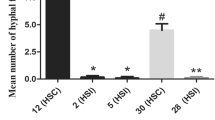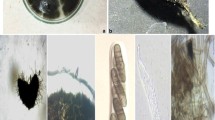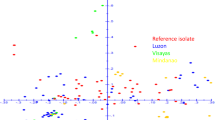Abstract
Isolates of Magnaporthe grisea causing gray leaf spot on rice were collected in Argentina and analyzed for mating distribution and fertility. One hundred and twenty-five isolates of M. grisea were collected from rice plants between 2000 and 2003. Each isolate was tested for mating type through a polymerase chain reaction based assay. All M. grisea isolates from Argentina belonged to a single mating type, MAT1.1. The fertility status of isolates was determined using controlled crosses in vitro, pairing each isolate with GUY11 and KA9 (MAT1.2 standard hermaphroditic testers). Production of perithecia was scarce among isolates of the blast pathogen since a low percentage of them (7.2%) developed perithecia with only one of the fertile tester (KA9); all crosses failed with the other tester strain. Asci and ascospores were not observed. The presence of only one mating type and the absence of female fertile isolates indicate that sexual reproduction is rare or absent in M. grisea populations associated with rice in Argentina.
Similar content being viewed by others
References
H Kato (1978) ArticleTitleBiological and genetic aspects in the perfect state of rice blast fungus, Pyricularia grisea Cav and its allies Mutation Breeding for Disease Resistance, Gamma Field Symposia 17 1–22
RS Zeigler (1998) ArticleTitleRecombination in Magnaporthe grisea Annu Rev Phytopathol 36 249–276 Occurrence Handle10.1146/annurev.phyto.36.1.249 Occurrence Handle15012500
M Levy J Romao MA Marchetti JE Hamer (1991) ArticleTitleDNA fingerprinting with a dispersed repeated sequence resolves pathotype diversity in the rice blast fungus Plant Cell 3 95–102 Occurrence Handle10.1105/tpc.3.1.95 Occurrence Handle12324580
M Levy FJ Correa-Victoria RS Zeigler S Xu JE Hamer (1993) ArticleTitleGenetic diversity of the rice blast fungus in a disease nursery in Colombia Phytopathology 83 1427–1433
Zeigler RS, Leong SA, Teng PS. Rice Blast Disease. UK: CAB International, Wallingford, Oxon, 1994
RS Zeigler RP Scott H Leung AA Bordeos J Kumar RJ Nelson (1997) ArticleTitleEvidence of parasexual exchange of DNA in the rice blast fungus challenges its exclusive clonality Phytopathology 87 284–294
SB Goodwin (1997) ArticleTitleThe population genetics of Phytophtora Phytopathology 87 462–473
NL Glass GA Kuldau (1992) ArticleTitleMating type and vegetative incompatibility in filamentous ascomycetes Annu Rev Phytopathol 30 201–224 Occurrence Handle10.1146/annurev.py.30.090192.001221
S Kang FC Chumley B Valent (1994) ArticleTitleIsolation of mating type genes of the phytopathogenic fungus Magnaporthe grisea using genomic substraction Genetics 138 289–296 Occurrence Handle7828813
TT Hebert (1971) ArticleTitleThe perfect stage of Pyricularia grisea Phytopathology 61 83–87
H Kato T Yamaguchi (1982) ArticleTitleThe perfect stage of Pyricularia oryzae Cay. from rice plants in culture Ann Phytopathol Soc Jpn 48 607–612
G Viji SS Gnanamanickam (1998) ArticleTitleMating type distribution and fertility of Magnaporthe grisea populations from various hosts in India Plant Dis 82 36–40
JL Notteghem D Silue (1992) ArticleTitleDistribution of mating type alleles in Magnaporthe grisea populations pathogenic on rice Phytopathology 82 421–424
R Benkirane M Tajani A Douira K Selmaoui S Lebrar (1998) ArticleTitleMating type of Magnaporthe grisea population in Morocco Phytopathol Mediterr 37 119–121
JA Kolmer AE Ellingboe (1988) ArticleTitleGenetic relationships and virulence to rice in Magnaporthe grisea Can J Bot 66 891–897
H Yaegashi N Nishihara (1976) ArticleTitleProduction of the perfect stage in Pyricularia from cereal and grasses Ann Phytopathol Soc Jpn 42 511–515
B Valent MS Crawford CG Weaver FG Chumley (1986) ArticleTitleGenetic studies of fertility and pathogenicity in Magnaporthe grisea Iowa State J Res 60 569–594
B Valent F Leonard FJ Chumley (1991) ArticleTitleMagnaporthe grisea genes for pathogenicity an virulence identified through a series of backcrosses Genetics 127 87–101 Occurrence Handle2016048
SY Park MG Milgroom SS Han S Kang YH Lee (2003) ArticleTitleDiversity of pathotypes and DNA fingerprint haplotypes in populations of Magnaporthe grisea in Korea over two decades Phytopathology 93 378–385
JR Xu JE Hamer (1996) ArticleTitleMAP kinase and cAMP signaling regulate infection structure formation and pathogenic growth in the rice blast fungus Magnaporthe grisea Gene Dev 10 187–194
C Xue G Park W Choi L Zheng RA Dean JR Xu (2002) ArticleTitleTwo novel fungal virulence genes specifically expressed in appresoria of the rice blast fungus Plant Cell 14 2107–2119 Occurrence Handle10.1105/tpc.003426 Occurrence Handle12215509
S Itoi T Mishima S Arase M Nozu (1983) ArticleTitleMating behavior of Japanese isolates of Pyricularia oryzae Phytopathology 73 155–158
H Yaegashi M Yamada (1986) ArticleTitlePathogenic races and mating types of Pyricularia oryzae from Soviet Union, China, Nepal, Thailand, Indonesia and Colombia Ann Phytopathol Soc Jpn 52 225–234
JF Leslie KK Klein (1996) ArticleTitleFemale fertility and mating type effects on effective population size and evolution in filamentous fungi Genetics 144 557–567 Occurrence Handle8889520
BV Dayakar NN Narayanan SS Gnanamanickam (2000) ArticleTitleCross-compatibility and distribution of mating type allels of the rice blast fungus Magnaporthe grisea in India Plant Dis 84 700–704
H Yaegashi (1977) ArticleTitleOn the sexuality of blast, Pyricularia from cereals and grasses Ann Phytopathol Soc Jpn 42 511–515
Y Tanaka N Murata H Kato (1979) ArticleTitleBehavior of nuclei and chromosomes during ascus development on the mating between either rice-strain or weeping lovegrass-strain and ragi strain of Pyricularia Ann Phytopathol Soc Jpn 45 182–191
JQ Xia JC Correll FN Lee MA Marchetti DD Rhodes (1993) ArticleTitleDNA fingerprinting to examine microgeographic variation in the Magnaporthe grisea (Pyricularia grisea) population in two rice fields in Arkansas Phytopathology 83 1029–1035
Sivaraj R, Gnanamanickam SS, Levy M. Studies on the genetic diversity of Pyricularia grisea: a molecular approach for the managment of rice blast. In: Rice Genetics III, The International Rice Research Institute, los Baños, Philippines, 1999: 958–962
LP Tredway K Stevenson LL Burpee (2003) ArticleTitleMating type distribution and fertility status in Magnaporthe grisea populations from turfgrasses in Georgia Plant Dis 87 435–441
N Hayashi C Li J Li M Iwano H Naito R Yoshino H Kato (1997) ArticleTitleDistribution of fertile Magnaporthe grisea fungus pathogenic to rice in Yunan Province, China Ann Phytopathol Soc Jpn 63 316–323
P Mekwatanakarn W Kositratana T Phromraksa RS Zeigler (1999) ArticleTitleSexually fertile Magnaporthe grisea rice pathogens in Thailand Plant Dis 83 939–943
J Kumar RJ Nelson RS Zeigler (1999) ArticleTitlePopulation structure and dynamics of Magnaporthe grisea in the Indian Himalayas Genetics 152 971–984 Occurrence Handle10388817
VB Priyadarisini G Viji SS Gnanamanickam (1999) ArticleTitleMating type distribution, fertility and pathogenicity of rice isolates of Magnaporthe grisea in four rice growing regions of India Phytopathology 52 28–34
Author information
Authors and Affiliations
Corresponding author
Rights and permissions
About this article
Cite this article
Consolo, V.F., Cordo, C.A. & Salerno, G.L. Mating-type Distribution and Fertility Status in Magnaporthe grisea Populations from Argentina. Mycopathologia 160, 285–290 (2005). https://doi.org/10.1007/s11046-005-4333-3
Received:
Accepted:
Issue Date:
DOI: https://doi.org/10.1007/s11046-005-4333-3




